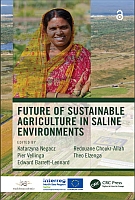Future of Sustainable Agriculture in Saline Environments
Proposal review
| dc.contributor.editor | Negacz, Katarzyna | |
| dc.contributor.editor | Vellinga, Pier | |
| dc.contributor.editor | Barrett-Lennard, Edward | |
| dc.contributor.editor | Choukr-Allah, Redouane | |
| dc.contributor.editor | Elzenga, Theo | |
| dc.date.accessioned | 2021-05-27T09:28:38Z | |
| dc.date.available | 2021-05-27T09:28:38Z | |
| dc.date.issued | 2021 | |
| dc.identifier | ONIX_20210527_9781000401141_37 | |
| dc.identifier | OCN: 1243906377 | |
| dc.identifier.uri | https://library.oapen.org/handle/20.500.12657/48840 | |
| dc.description.abstract | Food production on present and future saline soils deserves the world’s attention particularly because food security is a pressing issue, millions of hectares of degraded soils are available worldwide, freshwater is becoming increasingly scarce, and the global sea-level rise threatens food production in fertile coastal lowlands. Future of Sustainable Agriculture in Saline Environments aims to showcase the global potential of saline agriculture. The book covers the essential topics, such as policy and awareness, soil management, future crops, and genetic developments, all supplemented by case studies that show how this knowledge has been applied. It offers an overview of current research themes and practical cases focused on enhancing food production on saline lands. FEATURES Describes the critical role of the revitalization of salt-degraded lands in achieving sustainability in agriculture on a global scale Discusses practical solutions toward using drylands and delta areas threatened by salinity for sustainable food production Presents strategies for adaptation to climate change and sea-level rise through food production under saline conditions Addresses the diverse aspects of crop salt tolerance and microbiological associations Highlights the complex problem of salinity and waterlogging and safer management of poor-quality water, supplemented by case studies A PDF version of this book is available for free in Open Access at www.taylorfrancis.com. It has been made available under a Creative Commons Attribution-Non Commercial-No Derivatives 4.0 license. | |
| dc.language | English | |
| dc.subject.classification | bic Book Industry Communication::P Mathematics & science::PN Chemistry | |
| dc.subject.classification | bic Book Industry Communication::T Technology, engineering, agriculture::TV Agriculture & farming::TVF Sustainable agriculture | |
| dc.subject.classification | bic Book Industry Communication::T Technology, engineering, agriculture::TQ Environmental science, engineering & technology | |
| dc.subject.classification | thema EDItEUR::P Mathematics and Science::PN Chemistry | en_US |
| dc.subject.classification | thema EDItEUR::T Technology, Engineering, Agriculture, Industrial processes::TV Agriculture and farming::TVF Sustainable agriculture | en_US |
| dc.subject.classification | thema EDItEUR::T Technology, Engineering, Agriculture, Industrial processes::TQ Environmental science, engineering and technology | en_US |
| dc.subject.other | Environmental chemistry | |
| dc.subject.other | Sustainable agriculture | |
| dc.subject.other | Environmental science, engineering and technology | |
| dc.title | Future of Sustainable Agriculture in Saline Environments | |
| dc.type | book | |
| oapen.identifier.doi | 10.1201/9781003112327 | |
| oapen.relation.isPublishedBy | 7b3c7b10-5b1e-40b3-860e-c6dd5197f0bb | |
| oapen.relation.isbn | 9781000401141 | |
| oapen.relation.isbn | 9780367631475 | |
| oapen.relation.isbn | 9781003112327 | |
| oapen.relation.isbn | 9780367621469 | |
| oapen.imprint | CRC Press | |
| oapen.pages | 541 | |
| peerreview.anonymity | Single-anonymised | |
| peerreview.id | bc80075c-96cc-4740-a9f3-a234bc2598f1 | |
| peerreview.open.review | No | |
| peerreview.publish.responsibility | Publisher | |
| peerreview.review.stage | Pre-publication | |
| peerreview.review.type | Proposal | |
| peerreview.reviewer.type | Internal editor | |
| peerreview.reviewer.type | External peer reviewer | |
| peerreview.title | Proposal review | |
| oapen.review.comments | Taylor & Francis open access titles are reviewed as a minimum at proposal stage by at least two external peer reviewers and an internal editor (additional reviews may be sought and additional content reviewed as required). |

